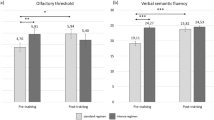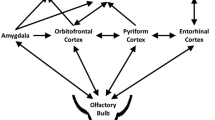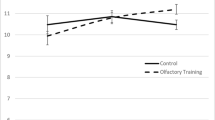Abstract
Repeated exposure to odors modifies olfactory function. Consequently, “olfactory training” plays a significant role in hyposmia treatment. In addition, numerous studies show that the olfactory bulb (OB) volume changes in disorders associated with olfactory dysfunction. Aim of this study was to investigate whether and how olfactory bulb volume changes in relation to lateralized olfactory training in healthy people. Over a period of 4 months, 97 healthy participants (63 females and 34 males, mean age: 23.74 ± 4.16 years, age range: 19–43 years) performed olfactory training by exposing the same nostril twice a day to 4 odors (lemon, rose, eucalyptus and cloves) while closing the other nostril. Before and after olfactory training, magnetic resonance imaging (MRI) scans were performed to measure OB volume. Furthermore, participants underwent lateralized odor threshold and odor identification testing using the “Sniffin‘ Sticks” test battery.
OB volume increased significantly after olfactory training (11.3 % and 13.1 % respectively) for both trained and untrained nostril. No significant effects of sex, duration and frequency of training or age of the subjects were seen. Interestingly, PEA odor thresholds worsened after training, while olfactory identification remained unchanged.These data show for the first time in humans that olfactory training may involve top-down process, which ultimately lead to a bilateral increase in olfactory bulb volume.

Similar content being viewed by others
References
Altundag, A., Salihoglu, M., Tekeli, H., Saglam, M., Cayonu, M., & Hummel, T. (2014). Lateralized differences in olfactory function and olfactory bulb volume relate to nasal septum deviation. The Journal of Craniofacial Surgery, 25(2), 359–362. doi:10.1097/SCS.0000000000000617.
Altundag, A., Cayonu, M., Kayabasoglu, G., Salihoglu, M., Tekeli, H., Saglam, O., et al. (2015). Modified olfactory training in patients with postinfectious olfactory loss. Laryngoscope, 125(8), 1763–1766. doi:10.1002/lary.25245.
Amoore, J. E. (1977). Specific anosmia and the concept of primary odors. Chemical Senses, 2, 267–281.
Askar, S. M., Elnashar, I. S., El-Anwar, M. W., Amer, H. S., El Shawadfy, M. A., Hosny, S. M., et al. (2015). Ipsilateral reduced olfactory bulb volume in patients with unilateral nasal obstruction. Otolaryngology and Head and Neck Surgery, 152(5), 959–963. doi:10.1177/0194599815573196.
Benson, T. E., Ryugo, D. K., & Hinds, J. W. (1984). Effects of sensory deprivation on the developing mouse olfactory system: a light and electron microscopic, morphometric analysis. The Journal of Neuroscience, 4(3), 638–653.
Bitter, T., Bruderle, J., Gudziol, H., Burmeister, H. P., Gaser, C., & Guntinas-Lichius, O. (2010). Gray and white matter reduction in hyposmic subjects--a voxel-based morphometry study. Brain Research, 1347, 42–47. doi:10.1016/j.brainres.2010.06.003.
Buschhuter, D., Smitka, M., Puschmann, S., Gerber, J. C., Witt, M., Abolmaali, N. D., et al. (2008). Correlation between olfactory bulb volume and olfactory function. NeuroImage, 42(2), 498–502. doi:10.1016/j.neuroimage.2008.05.004.
Cain, W. S., Stevens, J. C., Nickou, C. M., Giles, A., Johnston, I., & Garcia-Medina, M. R. (1995). Life-span development of odor identification, learning, and olfactory sensitivity. Perception, 24, 1457–1472.
Cleland, T. A., & Linster, C. (2003). Central olfactory structures. In R. L. Doty (Ed.), Handbook of olfaction and gustation (pp. 165–180). New York: Marcel Dekker.
Cleland, T. A., & Linster, C. (2005). Computation in the olfactory system. Chemical Senses, 30(9), 801–813. doi:10.1093/chemse/bji072.
Coppola, D. M. (2012). Studies of olfactory system neural plasticity: the contribution of the unilateral naris occlusion technique. Neural Plasticity, 2012, 351752. doi:10.1155/2012/351752.
Croy, I., Buschhuter, D., Seo, H. S., Negoias, S., & Hummel, T. (2010). Individual significance of olfaction: development of a questionnaire. European Archives of Oto-Rhino-Laryngology, 267(1), 67–71. doi:10.1007/s00405-009-1054-0.
Croy, I., Negoias, S., Symmank, A., Schellong, J., Joraschky, P., & Hummel, T. (2013). Reduced olfactory bulb volume in adults with a history of childhood maltreatment. Chemical Senses, 38(8), 679–684. doi:10.1093/chemse/bjt037.
Croy, I., Olgun, S., Mueller, L., Schmidt, A., Muench, M., Hummel, C., et al. (2015). Peripheral adaptive filtering in human olfaction? Three studies on prevalence and effects of olfactory training in specific anosmia in more than 1600 participants. Cortex, 73, 180–187. doi:10.1016/j.cortex.2015.08.018.
Cummings, D. M., Henning, H. E., & Brunjes, P. C. (1997). Olfactory bulb recovery after early sensory deprivation. The Journal of Neuroscience, 17(19), 7433–7440.
Dalton, P., Doolittle, N., & Breslin, P. A. (2002). Gender-specific induction of enhanced sensitivity to odors. Nature Neuroscience, 5, 199–200.
Damm, M., Pikart, L. K., Reimann, H., Burkert, S., Goktas, O., Haxel, B., et al. (2014). Olfactory training is helpful in postinfectious olfactory loss: a randomized, controlled, multicenter study. Laryngoscope, 124(4), 826–831. doi:10.1002/lary.24340.
Delon-Martin, C., Plailly, J., Fonlupt, P., Veyrac, A., & Royet, J. P. (2013). Perfumers' expertise induces structural reorganization in olfactory brain regions. NeuroImage, 68, 55–62. doi:10.1016/j.neuroimage.2012.11.044.
Ehrenstein, W. H., & Ehrenstein, A. (1999). Psychophysical methods. In U. Windhorst & H. Johansson (Eds.), Modern techniques in neuroscience research (pp. 1211–1241). Berlin: Springer.
Engen, T., & Bosack, T. N. (1969). Facilitation in olfactory detection. Journal of Comparative and Physiological Psychology, 68(3), 320–326.
Fleiner, F., Lau, L., & Goktas, O. (2012). Active olfactory training for the treatment of smelling disorders. Ear, Nose, & Throat Journal, 91(5), 198–203 215.
Folstein, M. F., Folstein, S. E., & McHugh, P. R. (1975). "Mini-mental state". A practical method for grading the cognitive state of patients for the clinician. Journal of Psychiatric Research, 12, 189–198.
Frasnelli, J., & Mercier, N. (2015). The effect of intensive training on olfactory performance. Paper presented at the annual meeting of ACHEMS, Bonita Springs, Florida, April 22-25
Geissler, K., Reimann, H., Gudziol, H., Bitter, T., & Guntinas-Lichius, O. (2014). Olfactory training for patients with olfactory loss after upper respiratory tract infections. European Archives of Oto-Rhino-Laryngology, 271(6), 1557–1562. doi:10.1007/s00405-013-2747-y.
Goektas, O., Schmidt, F., Bohner, G., Erb, K., Ludemann, L., Dahlslett, B., et al. (2011). Olfactory bulb volume and olfactory function in patients with multiple sclerosis. Rhinology, 49(2), 221–226. doi:10.4193/Rhino10.136.
Gudziol, V., Buschhuter, D., Abolmaali, N., Gerber, J., Rombaux, P., & Hummel, T. (2009). Increasing olfactory bulb volume due to treatment of chronic rhinosinusitis--a longitudinal study. Brain, 132(Pt 11), 3096–3101. doi:10.1093/brain/awp243.
Haehner, A., Rodewald, A., Gerber, J. C., & Hummel, T. (2008). Correlation of olfactory function with changes in the volume of the human olfactory bulb. Archives of Otolaryngology – Head & Neck Surgery, 134(6), 621–624. doi:10.1001/archotol.134.6.621.
Haehner, A., Tosch, C., Wolz, M., Klingelhoefer, L., Fauser, M., Storch, A., et al. (2013). Olfactory training in patients with Parkinson's disease. PloS One, 8(4), e61680. doi:10.1371/journal.pone.0061680.
Henning, H. (1916). Der Geruch. Leipzig: Johann Ambrosius Barth.
Huart, C., Rombaux, P., & Hummel, T. (2013). Plasticity of the human olfactory system: the olfactory bulb. Molecules, 18(9), 11586–11600. doi:10.3390/molecules180911586.
Hummel, T., Sekinger, B., Wolf, S., Pauli, E., & Kobal, G. (1997). "Sniffin' sticks": olfactory performance assessed by the combined testing of odor identification, odor discrimination and olfactory threshold. Chemical Senses, 22, 39–52.
Hummel, T., Rissom, K., Reden, J., Hahner, A., Weidenbecher, M., & Huttenbrink, K. B. (2009). Effects of olfactory training in patients with olfactory loss. Laryngoscope, 119(3), 496–499. doi:10.1002/lary.20101.
Hummel, T., Haehner, A., Hummel, C., Croy, I., & Iannilli, E. (2013a). Lateralized differences in olfactory bulb volume relate to lateralized differences in olfactory function. Neuroscience, 237, 51–55. doi:10.1016/j.neuroscience.2013.01.044.
Hummel, T., Henkel, S., Negoias, S., Galvan, J. R., Bogdanov, V., Hopp, P., et al. (2013b). Olfactory bulb volume in patients with temporal lobe epilepsy. Journal of Neurology, 260(4), 1004–1008. doi:10.1007/s00415-012-6741-x.
Hummel, T., Urbig, A., Huart, C., Duprez, T., & Rombaux, P. (2015). Volume of olfactory bulb and depth of olfactory sulcus in 378 consecutive patients with olfactory loss. Journal of Neurology, 262(4), 1046–1051. doi:10.1007/s00415-015-7691-x.
Kollndorfer, K., Kowalczyk, K., Hoche, E., Mueller, C. A., Pollak, M., Trattnig, S., et al. (2014). Recovery of olfactory function induces neuroplasticity effects in patients with smell loss. Neural Plasticity, 2014, 140419. doi:10.1155/2014/140419.
Konstantinidis, I., Tsakiropoulou, E., Bekiaridou, P., Kazantzidou, C., & Constantinidis, J. (2013). Use of olfactory training in post-traumatic and postinfectious olfactory dysfunction. Laryngoscope, 123(12), E85–E90. doi:10.1002/lary.24390.
Livermore, A., & Hummel, T. (2004). The influence of training on chemosensory event-related potentials and interactions between the olfactory and trigeminal systems. Chemical Senses, 29, 41–51.
Livermore, A., & Laing, D. G. (1996). Influence of training and experience on the perception of multicomponent odor mixtures. Journal of Experimental Psychology. Human Perception and Performance, 22, 267–277.
Mainland, J. D., Bremner, E. A., Young, N., Johnson, B. N., Khan, R. M., Bensafi, M., et al. (2002). Olfactory plasticity: one nostril knows what the other learns. Nature, 419, 802.
Mazal, P. P., Haehner, A., & Hummel, T. (2014). Relation of the volume of the olfactory bulb to psychophysical measures of olfactory function. European Archives of Oto-Rhino-Laryngology. doi:10.1007/s00405-014-3325-7.
Mori, E., Petters, W., Schriever, V. A., Valder, C., & Hummel, T. (2015). Exposure to odours improves olfactory function in healthy children Rhinology, 53(3), 221–226. doi:10.4193/Rhin14.192.
Mueller, A., Abolmaali, N. D., Hakimi, A. R., Gloeckler, T., Herting, B., Reichmann, H., et al. (2005). Olfactory bulb volumes in patients with idiopathic Parkinson's disease a pilot study. Journal of Neural Transmission, 112(10), 1363–1370. doi:10.1007/s00702-005-0280-x.
Negoias, S., Croy, I., Gerber, J., Puschmann, S., Petrowski, K., Joraschky, P., et al. (2010). Reduced olfactory bulb volume and olfactory sensitivity in patients with acute major depression. Neuroscience, 169(1), 415–421. doi:10.1016/j.neuroscience.2010.05.012.
Negoias, S., Aszmann, O., Croy, I., & Hummel, T. (2013). Localization of odors can be learned. Chemical Senses, 38(7), 553–562. doi:10.1093/chemse/bjt026.
Negoias, S., Hummel, T., Symmank, A., Schellong, J., Joraschky, P., & Croy, I. (2015). Olfactory bulb volume predicts therapeutic outcome in major depression disorder. Brain Imaging and Behavior. doi:10.1007/s11682-015-9400-x.
Neville, K. R., & Haberly, L. B. (2004). Olfactory cortex. In M. S. G. (Ed.), The Synaptic Organization of the Brain (pp. 415–454). New York: Oxford University Press.
Nguyen, A. D., Pelavin, P. E., Shenton, M. E., Chilakamarri, P., McCarley, R. W., Nestor, P. G., et al. (2011). Olfactory sulcal depth and olfactory bulb volume in patients with schizophrenia: an MRI study. Brain Imaging and Behavior, 5(4), 252–261. doi:10.1007/s11682-011-9129-0.
Patterson, A., Hahner, A., Kitzler, H. H., & Hummel, T. (2015). Are small olfactory bulbs a risk for olfactory loss following an upper respiratory tract infection? European Archives of Oto-Rhino-Laryngology. doi:10.1007/s00405-015-3524-x.
Podlesek, D., Leimert, M., Schuster, B., Gerber, J., Schackert, G., Kirsch, M., et al. (2012). Olfactory bulb volume in patients with idiopathic normal pressure hydrocephalus. Neuroradiology, 54(11), 1229–1233. doi:10.1007/s00234-012-1050-8.
Rabin, M. D., & Cain, W. S. (1986). Determinants of measured olfactory sensitivity. Perception & Psychophysics, 39(4), 281–286.
Rombaux, P., Mouraux, A., Bertrand, B., Nicolas, G., Duprez, T., & Hummel, T. (2006). Olfactory function and olfactory bulb volume in patients with postinfectious olfactory loss. Laryngoscope, 116(3), 436–439. doi:10.1097/01.MLG.0000195291.36641.1E.
Rombaux, P., Potier, H., Bertrand, B., Duprez, T., & Hummel, T. (2008). Olfactory bulb volume in patients with sinonasal disease. American Journal of Rhinology, 22(6), 598–601. doi:10.2500/ajr.2008.22.3237.
Rombaux, P., Huart, C., De Volder, A. G., Cuevas, I., Renier, L., Duprez, T., et al. (2010a). Increased olfactory bulb volume and olfactory function in early blind subjects. NeuroReport, 21(17), 1069–1073. doi:10.1097/WNR.0b013e32833fcb8a.
Rombaux, P., Potier, H., Markessis, E., Duprez, T., & Hummel, T. (2010b). Olfactory bulb volume and depth of olfactory sulcus in patients with idiopathic olfactory loss. European Archives of Oto-Rhino-Laryngology, 267(10), 1551–1556. doi:10.1007/s00405-010-1230-2.
Royet, J. P., Plailly, J., Saive, A. L., Veyrac, A., & Delon-Martin, C. (2013). The impact of expertise in olfaction. Frontiers in Psychology, 4, 928. doi:10.3389/fpsyg.2013.00928.
Rupp, C. I. (2010). Olfactory function and schizophrenia: an update. Current Opinion in Psychiatry, 23(2), 97–102. doi:10.1097/YCO.0b013e328336643f.
Schriever, V. A., Lehmann, S., Prange, J., & Hummel, T. (2014). Preventing olfactory deterioration: olfactory training may be of help in older people. Journal of the American Geriatrics Society, 62(2), 384–386. doi:10.1111/jgs.12669.
Thomann, P. A., Dos Santos, V., Toro, P., Schonknecht, P., Essig, M., & Schroder, J. (2009). Reduced olfactory bulb and tract volume in early Alzheimer's disease--a MRI study. Neurobiology of Aging, 30(5), 838–841. doi:10.1016/j.neurobiolaging.2007.08.001.
Turetsky, B. I., Moberg, P. J., Yousem, D. M., Doty, R. L., Arnold, S. E., & Gur, R. E. (2000). Reduced olfactory bulb volume in patients with schizophrenia. The American Journal of Psychiatry, 157, 828–830.
Veyseller, B., Ozucer, B., Aksoy, F., Yildirim, Y. S., Gurbuz, D., Balikci, H. H., et al. (2012). Reduced olfactory bulb volume and diminished olfactory function in total laryngectomy patients: a prospective longitudinal study. American Journal of Rhinology & Allergy, 26(3), 191–193. doi:10.2500/ajra.2012.26.3768.
von Gudden, B. (1870). Experimentaluntersuchungen über das peripherische und Centrale Nervensystem. Archiv für Psychiatrie und Nervenkrankheiten, 2(3), 693–723.
Wang, L., Chen, L., & Jacob, T. (2004). Evidence for peripheral plasticity in human odour response. The Journal of Physiology, 554, 236–244.
Yousem, D. M., Geckle, R. J., Bilker, W. B., McKeown, D. A., & Doty, R. L. (1996). Posttraumatic olfactory dysfunction: MR and clinical evaluation. AJNR. American Journal of Neuroradiology, 17(6), 1171–1179.
Yousem, D. M., Geckle, R. J., Doty, R. L., & Bilker, W. B. (1997). Reproducibility and reliability of volumetric measurements of olfactory eloquent structures. Academic Radiology, 4, 264–269.
Yousem, D. M., Geckle, R. J., Bilker, W. B., & Doty, R. L. (1998). Olfactory bulb and tract and temporal lobe volumes. Normative data across decades. Annals of the New York Academy of Sciences, 855, 546–555.
Yousem, D. M., Geckle, R. J., Bilker, W. B., Kroger, H., & Doty, R. L. (1999). Posttraumatic smell loss: relationship of psychophysical tests and volumes of the olfactory bulbs and tracts and the temporal lobes. Academic Radiology, 6, 264–272.
Author information
Authors and Affiliations
Corresponding author
Ethics declarations
Funding
The study did not receive external funding.
Conflict of interest
None of the authors declares any conflict of interest.
Ethical approval
All procedures performed in studies involving human participants were in accordance with the ethical standards of the institutional and/or national research committee and with the 1964 Helsinki declaration and its later amendments or comparable ethical standards.
Informed consent
Informed consent was obtained from all individual participants included in the study.
Rights and permissions
About this article
Cite this article
Negoias, S., Pietsch, K. & Hummel, T. Changes in olfactory bulb volume following lateralized olfactory training. Brain Imaging and Behavior 11, 998–1005 (2017). https://doi.org/10.1007/s11682-016-9567-9
Published:
Issue Date:
DOI: https://doi.org/10.1007/s11682-016-9567-9




